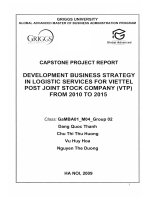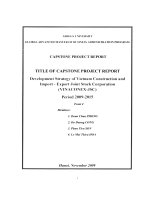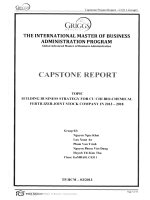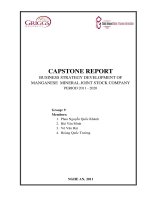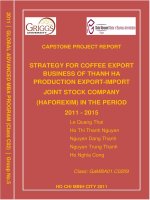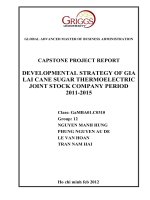Developmental strategy of Gia Lai cane sugar thermoelectric joint stock company period 2011-2015 c
Bạn đang xem bản rút gọn của tài liệu. Xem và tải ngay bản đầy đủ của tài liệu tại đây (1.12 MB, 114 trang )
Capstone Project Report
GLOBAL ADVANCED MASTER OF BUSINESS ADMINISTRATION
CAPSTONE PROJECT REPORT
DEVELOPMENTAL STRATEGY OF GIA
LAI CANE SUGAR THERMOELECTRIC
JOINT STOCK COMPANY PERIOD
2011-2015
Class: GaMBA01.C0310
Group: 12
NGUYEN MANH HUNG
PHUNG NGUYEN AU DE
LE VAN HOAN
TRAN NAM HAI
Ho chi minh feb 2012
Capstone Project Report
C0310.Group 12# Page i
UNDERTAKING
The Graduation Capstone Project with the theme of “Developmental strategy
of Gia Lai Cane Sugar –Thermoelectricity Joint Stock Company, period 2011 –
2015” is the researching work by Group 12.
We undertake that the contents of report are true and have not been published
in any scientific work.
The data used in this report have been consented by Gia Lai Cane Sugar –
Thermoelectricity Joint Stock Company. All documents in use are specified the
citing sources in the List of Reference.
HoChiMinh City, March 15
th
, 2012
Implemented by
Group 12 – Class GaMBA01.C0310
Capstone Project Report
C0310.Group 12# Page ii
THANKS
The author group of Graduation Capstone Project for the training program of Global
Advanced Master of Business Administration by Griggs University, Andrew USA,
school year 2010 – 2012, would like send to the Teachers, the Management Board
of Class and the class-fellows who assist us to make this Thesis.
We sincerely thank the ETC Center – Hanoi National University for facilitating us
during the process of MBA course under the training program by Griggs University,
Andrew USA.
We are deeply grateful to the Teachers who have wholeheartedly taught and
imparted the very precious knowledge to us so that we can apply it into our works
in the future.
Also, we are thankful to the Guidance Board, Specialistic Group, especially Dr. Le
Van Bay who has conducted and assist us until completion of this Thesis.
By this Thesis, thanks a lot to the leadership of Gia Lai Cane Sugar –
Thermoelectricity Joint Stock Company, Departments and Divisions, Agriculture
Department, Project Management Board, Accounting Department, etc for
cooperation and providing the orientation, documents and data so that we can
complete this Thesis.
Finally, we would like to express our deep gratitude and love to our all family
members for encouraging and creating the best conditions for us to complete this
courses.
Thanks with sincerity!
Capstone Project Report
C0310.Group 12# Page iii
CONTENTS
FOREWORD 1
1. THE NECESSITY OF RESEACH. 1
2. OBJECTIVE OF RESEARCH. 2
3. OBJECT AND SCOPE OF RESEARCH 2
4. METHOD OF RESEARCH 3
5. SCIENTIFIC AND PRACTICAL MEANINGS OF THE THEME. 3
6. STRUCTURE OF THESIS. 3
CHAPTER 1 .LITERATURE REVIEW OF BUSINESS STRATEGY 4
1.1.LITERATURE REVIEW OF STRATEGIC MANAGEMENT 4
1.1.1.Definition 4
1.1.2.Advantages of strategy 5
1.1.3.Strategies 5
1.1.3.1.Strategic levels 5
1.1.3.2.Types of strategies 6
1.1.4.The process of strategic administration 7
1.1.4.1.The formation of strategy 8
1.1.4.2.The stage of strategy implementation: 10
1.1.4.3.Stage of strategy assessment: 10
1.2.THE THEORY OF STRATEGIC MATRIX 11
1.2.1.External Factor Evaluation Matrix. 11
1.2.2.Internal Factor Evaluation Matrix. 11
1.2.3.Competitive Profile Matrix. 11
1.2.4. SWOT Matrix. 11
1.2.5.BCG Matrix. 13
1.2.6.SPACE Matrix. 16
1.2.7.Selection of Quantitative Strategic Planning Matrix – QSPM. 17
Capstone Project Report
C0310.Group 12 Page iv
CHAPTER 2.GIA LAI CANE SUGAR – THERMOELECTRICITY JOINT
STOCK COMPANY 19
2.1.Ntroduction Of Gia Lai Cane Sugar-Thermoelectricity Join Stock Company 19
2.1.1.Overview: 19
2.1.2.The company
’
s background and development history: 20
2.1.3. Business lines: 21
2.1.4.Mission and vision of strategy: 22
2.1.5.Organizational structure: 22
2.1.6.Customers and partners: 23
2.1.7.Business results within 3 years (2009 – 2011): 24
2.2.ANALYSIS OF THE INTERNAL ENVIRONMENT IN THE COMPANY 29
2.2.1.Overview: 29
2.2.2.Management: 30
2.2.3.Control 31
2.2.4.Management and development of the material zone 32
2.2.4.1.Management of the material zone: 32
2.2.4.2.Development of material regions: 33
2.2.5.The plant
’
s production 34
2.2.6.Marketing and management of customers system 36
2.2.6.1.Brand marketing 36
2.2.6.2.Distribution channel and customers system 36
2.2.7.For financial accounting 36
2.2.8.Management of risks 37
2.3.Factors From External Environment 38
2.3.1.Analysis of macro factors, industry factors to the company. 38
2.3.1.1.Analysis of macro factors on economy and society 38
2.3.1.1.1.Policies 38
2.3.1.1.2.Economy 39
Capstone Project Report
C0310.Group 12 Page v
2.3.1.1.3.Economy, society – consuming tastes 39
2.3.1.1.4.Production technology 39
2.3.1.1.5.Trend of globalization – International commitment of CEPT and
WTO 40
2.3.1.2.Global sugar market in the crop 2011 - 2012 43
2.3.1.3.Current status of Vietnam cane-sugar industry 45
2.3.1.4.Michael Porter Five Forces Model 52
2.3.1.5.Competitive pressure of materials will change in the
fierce direction. 52
2.3.1.6.Internal competitive pressure is not serious among sugar plants in
Vietnam (currently.) 53
2.3.1.7.Competitive pressure from substitutes is not significant. 53
2.3.1.8.Distribution system affects mainly to speed of sugarcane
consumption at plants. 54
2.3.1.9.Major competitive pressure is derived from rivals in ASENAN
when CEPT/AFTA is effective completely. 54
2.3.2.Analysis of competitors 55
2.3.2.1.Bourbon Tay Ninh - SBT 55
2.3.2.2.Ninh Hoa Sugar - NHS 56
2.3.2.3.Bien Hoa Sugar - BHS 57
2.3.2.4.Quang Ngai Sugar - QNS 58
2.3.2.5.Kon Tum Sugar - KTS 59
CHAPTER 3.GIA LAI CANE SUGAR - THERMOELECTRICITY JOINT
STOCK COMPANY, PERIOD 2011 -2015 60
3.1.BUILDING THE STRATEGIC TARGETS 60
3.1.1.Prospect of the global sugar-cane industry 60
3.1.2.Developmental orientation of SEC in the period of 2011- 2015 62
Capstone Project Report
C0310.Group 12 Page vi
3.2.OBJECTIVES OF SEC IN THE PERIOD OF 2011 – 2015: 63
3.3.APPLICATION OF MATRICES IN THE CONSTRUCTION OF
BUSINESS STRATEGY FOR SEC IN THE PERIOD OF 2011-2015, AND
VISION 2020. 63
3.3.1.External Factor Evaluation Matrix (EFE) 64
3.3.2.Evaluation of competitive ability 65
3.3.2.1.Position and evaluation of SEC’s competitive ability within
the trade 65
3.3.2.2.Comparison and evaluation of SEC’s competitors such as KTS
and NHS. 68
3.3.2.3.Competitive Picture Matrix (CPM) 71
3.3.3.Internal Factor Evaluation Matrix (IFE) 73
3.3.4.SWOT Matrix 74
3.3.5.SPACE Matrix 77
3.3.6.Quantitative Strategic Planning Matrix (QSPM) 79
3.4.ORGANIZATION OF STRATEGIC IMPLEMENTATION 83
3.4.1.Solution for marketing distribution, implementing “strategy C” 83
3.4.2.Solution for developing sugarcane material zone, implementing “strategy B” 84
3.4.3.Solution for raising plant capacity, implementing “strategy A” 86
3.5.FINANCIAL TARGETS EXPECTED TO IMPLEMENT PERIOD 2011-2015 . 88
3.6.RECOMMENDATIONS 90
CONCLUSION 93
REFERENCES 95
APPENDICES 96
Capstone Project Report
C0310.Group 12 Page vii
LIST OF FIGURES
Figure 1.1. Overall strategic administration 8
Figure 1.2. The model of five competitive forces of Michael E. Porter 9
Figure 1.3. SWOT matrix 12
Figure 1.4. BCG Matrix 15
Figure 1.5. QSPM matrix 18
Figure 2.1. Image of Gia Lai Cane Sugar Thermoelectricity
Joint Stock Company 20
Figure 2.2. Organization chart of SEC 23
Figure 2.3. Sales structure by customers 24
Figure 2.4. Outputs of finishes products have grown over years 25
Figure 2.5. Revenue structure ratio 25
Figure 2.6. Revenues and profits 26
Figure 2.7. Chart of profit targets 2007-2011 27
Figure 2.8. Targets of utilization effect 27
Figure 2.9. Financial targets 28
Figure 2.10. Target of capital structure 28
Figure 2.11. Area of the material regions 33
Figure 2.12. SEC’s logo 36
Figure 2.13. The supply and demand of the global sugars 43
Figure 2.14. Sugarcane outputs during1990-2009 47
Figure 2.15. Sugar output in Vietnam - Thailand and Philippines 47
Figure 2.16. Sugarcane area over years in Vietnam and the world 48
Figure 2.17. Chart of sugarcane cultivation by region in Vietnam 48
Figure 2.18. Chart of production cost by regions 51
Figure 2.19. Sugar output of the factories in the crop of 2010-2011 58
Figure 3.1. The world sugar price from Jan, 2010 to August, 2011 62
Figure 3.2. Images of cautious strategy of SPACE Matrix 78
Figure 3.3 Strategy for stable growth: forward, backward combination 83
Capstone Project Report
C0310.Group 12 Page viii
LIST OF TABLES
Table 2.2. Business lines of the SEC 21
Table 2.3. Suppliers of materials for SEC 24
Table 2.4. Expansion of material regions 34
Table 2.5. Form of sugarcane in the crop of 2010/2011 34
Table 2.6. Production activities 2009-2011 35
Table 2.7. Import tariff under WTO commitments 41
Table 2.8. Rate of tazation under committments 41
Table 2.9. Schedule of tax imposition 42
Table 2.10. Schedule of tax reduction 43
Table 2.11. Criteria for evaluating Vietnam
’
s sugarcane industry 45
Table 2.12. Sugarcane area targets 46
Table 2.13. Performance of pressed sugarcane 49
Table 2.14. Capacity for pressing 49
Table 2.15. Capacity of sugarcane factories in Vietnam 50
Table 2.16. Statistics of sugar production cost in regions 51
Table 3.1. External Factor Evaluation Matrix of SEC 64
Table 3.2. Comparison of the leading sugarcane enterprises in Viet Nam 67
Table 3.3. Comparison of financial targets of SEC’s competitors such as KTS, NHS
69
Table 3.4. Comparison of business outcome and capital structure of SEC, KTS,
NHS in 2011 70
Table 3.5. Comparison of developmental plans of SEC, KTS, NHS in the period of
2012-2020 70
Table 3.6. Competitive Picture Matrix 72
Table 3.7. Internal Factor Evaluation matrix 73
Table 3.8. SWOT Matrix 75
Table 3.9. SPACE Matrix 77
Table 3.10. QSPM Matrix 80
Capstone Project Report
C0310.Group 12 Page ix
Table 3.11. Increasing plant capacity from 2011 to 2015 87
Table 3.12. Revenue – expenses expected in 2011-2015 89
Table 3.13. Key indicators expected to reach 2011-2012 periods 90
Capstone Project Report
C0310.Group 12 Page ix
LIST OF ABBREVIATION
ASEAN : Association of Southeast Asian Nations
AFTA : ASEAN Free Trade Area (according to Preferential Tariff agreement)
CEPT : Common Effective Preferential Tariff (Tax breaks within 0-5%)
SEC : Abbreviated name of Gia Lai Cane Sugar – Thermoelectricity Joint Stock
Company
KTS : Abbreviated name of Kon Tum Cane Sugar Joint Stock Company
NHS : Abbreviated name of Ninh Hoa Cane Sugar Joint Stock Company
LSS : Abbreviated name of Lam Son Cane Sugar Joint Stock Company
BHS : Abbreviated name of Bien Hoa Cane Sugar Joint Stock Company
SBT : Abbreviated name of Bourbon Tay Ninh Cane Sugar Joint Stock
Company
RE : Refined Extra
RS : Refined Standard
Tons/day : Ton of sugarcane/day
UBCKNN: State Securities Commission
OECD : Organization of Cooperation and Economic Development
GDP : Gross Domestic Product
ISO : International Sugar Organization
WTO : World Trade Organization
Capstone Project Report
C0310.Group 12 Page 1
FOREWORD
1. THE NECESSITY OF RESEACH.
Sugar is an essential product item for consumption. All countries which specialize
in manufacturing and processing sugar have their own policies for the trade in order
to ensure the stability and satisfy domestic consumption demands. Many countries
all over the world have great advantages of sugar production and processing such as
Brazil, Thailand, India, etc…
There are some countries with high sugar consumption such as India, China and
European countries, etc When their policies of supply and demand have been
changed, the sugar industry of the world is also influenced and governed very much,
this causes the fluctuation about supply and demand, prices, reserve Most of
countries make sugar from canes with high productivity. In addition, the European
countries manufacture and process sugar from beets, this also contributes to the
global sugar supplying sources.
Demand of sugar consumption is higher, especially demand for medical production,
soft drink, confectionery industries, is considerable. However, the variation of
prices and the competition between the factories, the nations in the flat world are
more and more fierce while the resources are less and less; development of sciences
and technology is not an exclusive strength for any country; the world economy is
in recession; inflation and interest rate are in the high level. Facing with those
challenges, the nations are required to have policies for food security, community
health. In the face of fierce competition at home and abroad, the companies of
manufacture, processing and commerce in the market economy are required to have
the long-term strategies for coping with the challenges and utilizing the
opportunities.
Gia Lai Cane Sugar – Thermoelectricity Joint Stock Company (SEC) is one of the
sugar cane companies of developmental potentiality with large and stable raw
material zone. It is a great advantage as well as a ground for planning long-term
Capstone Project Report
C0310.Group 12 Page 2
strategies for companies of sugar cane industry so that they can develop their
companies under the orientation of competition and stability.
The objectives and the tasks of SEC currently and in the coming stage, are:
keeping the area of raw material zone in stable; developing effectively and raising
the quality of products from canes; satisfying market demands; ensuring ultimate
benefits of the sugarcane planters, benefits of shareholders, division of profits and
parties association to make sure that it is harmonious and steadfast; and many issues
are posed that should be handled in the company’s developmental strategy, period
2011 – 2015.
2. OBJECTIVE OF RESEARCH.
Researching and evaluating the economic- political - social situations and policies
of the State, national strategic objective for cane-sugar industry.
By analyzing the impacts from the factors and the company’s operation real status,
from that point, lay out the strategies and solutions for effective implementation of
company development in the period 2011 – 2015, vision 2020.
3. OBJECT AND SCOPE OF RESEARCH.
Researched object of the Thesis is the real status of business and production
operation in Gia Lai Cane Sugar – Thermoelectricity Joint Stock Company. The
thesis focuses on the practical theory of the Company’s operation status and
developmental strategy, raising the efficiency of raw material zone, quality of
product from sugarcanes, using and ultimately promoting the resources (capital,
workforce, technology ) in order to strengthen the competitive ability of the
company, contribute to the socio-economic development of Kon Tum province in
particular and development of Vietnam cane-sugar industry in general.
Scope of research: the theme is placed in the context of Vietnam cane-sugar
industry coming up against the competition of imported sugar product; the sugar
production technology of Vietnam is almost obsolete and backward. How to
increase competitive ability and survive in the world with full of variations is a
great challenge.
Capstone Project Report
C0310.Group 12 Page 3
4. METHOD OF RESEARCH.
Method of analysis and aggregation: the members of research group will analyze,
aggregate the information sources from inside the company and external factors,
information from competitors to put forward the strengths and weaknesses in the
business and production process from there, evaluate the competitive ability of the
company in the current time as well as developmental plan in the future.
Method of comparison and matching: Matching the theory and reality to find out
and solve the difficulties and challenges in expanding production scale of new
service types and raising the product quality. Comparing SEC’s competitive ability
and other cane-sugar companies’ in the same area to find out the difference, thereby
we can evaluate the current ability of SEC.
Additionally, we have applied statistical method, collect and analyze the
quantitative data to make clear the related contents in the Thesis.
5. SCIENTIFIC AND PRACTICAL MEANINGS OF THE THEME.
We go deeply into researching the real status of business and production operation
in Gia Lai Cane Sugar – Thermoelectricity Joint Stock Company, from that point;
help the Leadership of Company have a general view on cane-sugar market,
competitive ability and developmental plan in the future.
6. STRUCTURE OF THESIS.
Apart from foreword, conclusion and list of reference, the Thesis will be presented
by three chapters as follows:
* Chapter 1 : Literature review of strategies.
* Chapter 2 : Business and production operations of Gia Lai Cane Sugar –
Thermoelectricity Joint Stock Company.
* Chapter 3 : Building Business strategy for Gia Lai Cane Sugar – Thermoelectricity
Joint Stock Company, period 2011 – 2015.
Capstone Project Report
C0310.Group 12 Page 4
CHAPTER 1
LITERATURE REVIEW OF BUSINESS STRATEGY
1.1. LITERATURE REVIEW OF STRATEGIC MANAGEMENT
1.1.1.Definition
“Strategy” comes from military affairs used to indicate task plan for the
success on the foundation of information of whether the competitors can or can’t
do. Also, in business, enterprises are formed along with their own products and
these enterprises adjust their products, services and policies to deal with their
competitors, demands of customers and changes in business. They have to set out
strategic objectives and plans for their enterprise to survive in business environment
There are different definitions of “Strategy” as follows:
“Strategy is to determine long-term and primary objectives, targets of an
enterprise and the adoption of a series of actions and the allocation of essential
resources in order to obtain these objectives” - Chandler (1962)
“Strategy is the coordinating factor between the enterprise and business
environment: the consistent model of decisions of the enterprise in accordance with
the business environment”- Mintzberg (1979)
“Strategy is a model or plan tightly integrated with primary objectives,
policies and actions” - Quinn (1980)
“Strategy is the difference. It indicates the selection basing on series of
different action forming unique value”- Michael E. Porter (1996)
“Strategy is mean to achieve long-term targets” - Fred R. David (2003)
“Strategy is to orient the administration and ensure primary objectives and
targets of the enterprise are completed for a long-term period”- Rudolf Grunig and
Richard Kuhn (2003)
Therefore, though there are different ways to define “Strategy”, a business
strategy includes the following key contents:
Determining primary and long-term objectives of the enterprise
Capstone Project Report
C0310.Group 12 Page 5
Adopting general program of action.
Selecting the action plan, deploy and distribute resources to achieve these objectives.
1.1.2.Advantages of strategy
Business orientation: Strategic administration is advantageous in helping
enterprises to generate better business orientation through a more systematic,
reasonable and logic approach to the strategy selection
Financial administration: Strategic administration helps enterprises
manage their financial situation more efficiently thanks to the process of analyzing
and forecasting micro and macro economy in the future. The study of Cook and
Ferris has shown that 80% of 101 studied companies have been able to improve
their profit through the change in their business strategy.
Identifying opportunities and risks: Strengths and weaknesses of the
company are identified through the external conditions so that strengths are developed,
weaknesses are minimized and measures are applied to prevent outside threats.
Improve the competitive advantages: Analyze and select feasible strategies
via tools and information so as to improve competitive advantages and avoid risks.
Classification of strategies: There are many different types of strategies in a
company, depending on the level, approach… Business strategies can be classified
as follows:
1.1.3.Strategies
1.1.3.1.Strategic levels
From the point of strategic levels, there are at least three following strategic
levels in a company:
Corporate level strategies: Those aims to the overall scope and goals of the
company.
Business unit level strategies: Those relating to how to successfully compete
in a specific market…
Capstone Project Report
C0310.Group 12 Page 6
Functional strategies: (departmental strategies) those help company-level
strategies and business unit-level strategies effectively implemented through their
components in terms of resources, human-based processes and required skills.
In the globalizing conditions of fierce competition, borders between
countries have been removed, resulting in the coming of the forth-strategic level –
that is the global strategy.
1.1.3.2.Types of strategies
a. Corporate level strategy
Corporate strategy aims to long-term and primary goals; therefore, there are
many types of corporate strategies in different names. According to Fred R. David,
there are 14 types of primary corporate-level strategies as follows:
Integrated strategies
9 Forward integration
9 Backward integration
9 Horizontal integration
Specified strategies
9 Market Penetration
9 Market Development
9 Product Development
9 Diversification
9 Horizontal Diversification
9 Conglomerate Diversification
Other strategies
9 Joint Venture
9 Retrenchment
9 Divestiture
9 Liquidation
9 Mixed strategy
Capstone Project Report
C0310.Group 12 Page 7
b. Business unit level strategy
Business unit level strategy concerns about how to successfully compete in a
specific market. Business strategy includes the competition measures of company,
the ways which companies determine in order to gain competitive advantages and
the different strategies used in the context of business.
According to Michael E. Porter, there are three key competitive strategies of
business level as follows:
9 Cost leadership strategy: (The lowest and the best cost)
9 Strategy of product difference
9 Focus strategy
c. Functional strategy
Functional strategy is strategy of functional division like Marketing, Finance,
Human resource….These strategies help to improve the operating efficiency of an
enterprise and to support business unit strategy and corporate strategy.
1.1.4.The process of strategic administration
According to Fred R. David, strategic administration consists of three steps:
The formation of strategy, the implementation and the evaluation of the strategy.
Capstone Project Report
C0310.Group 12 Page 8
(Source: Fred. David – Outline of strategic administration)
Figure 1.1. Overall strategic administration
1.1.4.1.The formation of strategy
The formation of strategy is the process of forming business goals,
investigating and studying to identify internal and external weaknesses, so that
long-term goals are set out and there are substitutive strategies
a. Analyze the external conditions
External conditions are analyzed aiming at developing a lists of things
restrict opportunities of company and threats which should be avoided in order to
minimize negative impacts of external conditions. There are many different external
factors (micro and macro factors); therefore, only external factors which strongly
affect company should be analyzed
Macro conditions include:
9 Economic condition,
9 Politic and legal conditions
9 Cultural and social conditions
Allocate
resourc
es
Redetermine
business
goals
Analyzeinternal
goals.Identify the
strengths and
weaknesses.
Select
appropri
ate
strategy
Adopt
policy
Formation of strategy Implementation
Vision,
role,
and
strategic
goals
Analyzeexternal
conditions,
determine
opportunities
andrisks
Measure
and
evaluate
the
implement
ationofthe
strategy
Setout
long
term
goals
Setout
annual
goals
Capstone Project Report
C0310.Group 12 Page 9
9 Population and geographical conditions
9 Technological conditions
9 Global conditions
Micro conditions: are external factors affecting the company, determining
the nature and extend of competition in business field.
Michael E. Porter, Professor of business strategy of Harvard, has given a
model of five competitive forces as Figure 1-2
(Source: Griggs University – Strategic administration textbook)
Figure 1.2. The model of five competitive forces of Michael E. Porter
a. Analyze the internal conditions
There are strengths and weaknesses in business units of a company. Internal
conditions are:
9 Finance: Includes factors in term of financial capacity, financial
administration, financial accounting
9 Management: Includes management activities to ensure performance of
the actual production and business in accordance with expected plans:
Management capacity of human resource, material, finance, and sales
9 Marketing: Marketing is the process of identifying, forecasting, building
and satisfying demands of customers to products and services. Marketing
administration includes the research of market developing, selection of
target market, the system of distribution, the after-sales service
NEWPOTENTIAL
COMPETITORS
COMPETITOROFTHE
SAMEINDUSTRY
CUSTOMERS
SUPPLIER
SUBSTITUTIVE
PRODUCTS
Capstone Project Report
C0310.Group 12 Page 10
9 Human resource: The human resource plays a key role in the success of a
company. In spite of a proper business strategy, it will not bring the
efficiency without the effective performance of human resource. Human
resource factor includes: Structure, qualification, policy and development
of human resource,
9 Production administration and implementation: Includes all activities
to alter inputs into goods and services of a company. The process of
production and implementation includes: The design process of
production, the selection of the technology, scope of production; the
location, layout; the quality of products, service and cost of production.
9 The information system: The system is to link all business functions and
provide the basic of administrative decisions. It receives raw data from the
external and the internal conditions. An effective information system will
help improve understandings of business functions, improve the
communication, supply more information for the determination, analyze
obstacles, and consolidate the operation.
1.1.4.2.The stage of strategy implementation:
Enforcing the strategy is often called the action stage of strategic
management, which is shown through mobilizing all the members of the company
to implement the developed strategy.
The implement the business strategies effectively, the corporation need:
9 Establish the short-term target
9 Adjust the organizational structure
9 Make the policies
9 Set up budget
9 Develop corporation's culture
1.1.4.3.Stage of strategy assessment:
Assessing the effectiveness of a business strategy is very important. A
business strategy is considered to be effective in case it is compliant with the actual
Capstone Project Report
C0310.Group 12 Page 11
situation of the corporation and the socio-economic status as well as it can make the
most of opportunities to achieve the objectives set out by the corporation. Assessing
the business strategy include the following steps:
9 Reviewing and checking the appropriateness of business strategies before
implementation.
Assessing the effectiveness of production and business activities of the
corporation at each implementation stage in order to timely find out defects of the
strategy whereby to adjust, correct and supplement.
1.2. THE THEORY OF STRATEGIC MATRIX
1.2.1.External Factor Evaluation Matrix.
EFE matrix is a tool used to summarize and assess the external information of
the corporation such as macro-economic factors: policy, law, society, science, and
nature.
1.2.2. Internal Factor Evaluation Matrix.
EFE matrix is a tool used to summarize and assess the strengths and
weaknesses of the business sections, and it also supplies the basis to determine and
assess the relation among these sections.
1.2.3.Competitive Profile Matrix.
Competitive Profile Matrix identifies the major competitors and their
advantages and disadvantages. This matrix is the extension of EFE matrix in case
the importance, classification and total important points have the same meaning.
The total assessed points of the competitors are compared with the sample
companies. The special classification of competitors can be compared with the
classification level of the sample companies. This comparative analysis gives
important strategic information.
1.2.4. SWOT Matrix.
SWOT matrix is a very useful tool for understanding and making decisions
in any situation for any corporation. SWOT stands for Strengths, Weaknesses,
Oppotunities and Threats Strengths and Weaknesses are the internal factors of
Capstone Project Report
C0310.Group 12 Page 12
the Corporation and Opportunities and Threats are the external factors of SWOT
which allows to analyze different factors with relative impacts on the
competitiveness of the Corporation.
SWOT often sets out 4 basic strategies: (1) SO (Strengths - Opportunities):
the strategies usually base on the advantages of the company to take advantage of
market opportunities. (2) WO (Weaks - Opportunities): the strategies usually base
on the ability to overcome the weaknesses of the company to take advantage of
market's opportunities. (3) ST (Strengths - Threats): the strategies base on the
company's predominance to avoid the market's threats. (4) WT (Weaks - Threats):
the strategies base on the ability to overcome or minimize the company's
weaknesses of the company to avoid the market's threats.
Figure 1.3. SWOT matrix
SWOT Analysis is suitable with assessing actual situation of the company
through analisis of internal situation (Strengths and Weaknesses) and external
Capstone Project Report
C0310.Group 12 Page 13
situations (Opportunities và Threats) of the company. SWOT screens information
in an intelligent order.
The internal factors need be analyzed are:
- Company's culture.
- Company's image
- Organizational structure.
- Key manpower.
- Using ability of all resources.
- Obtained experiences.
- Operation's effects.
- Performance ability.
- Fame of trade mark
- Market share.
- Financial source.
- Key contract.
- Copyright and trading secretes
External factors need be analyzed are: customers, competitors, market
tendency, supplier, partners , society's changes., new technology, economic
environment., political and legal environments.
The quality of SWOT analysis depends on quality of the collected
information. The informaton should be collected from all aspects: directorate,
customers, partners, suppliers, strategic partners, consultants etc SWOT is
somewhat limited in organizing information with summary tendency. This may put
the information in inappropriate position with the matter's nature. Many titles may
be neutralized or confused between S-W and O-T at the analyst's discretion.
1.2.5.BCG Matrix.
Boston Consulting Group (BCG) Matrix is a four celled matrix (a 2 * 2
matrix) developed by BCG, USA. It is the most renowned corporate portfolio
analysis tool. It provides a graphic representation for an organization to examine
Capstone Project Report
C0310.Group 12 Page 14
different businesses in its portfolio on the basis of their related market share and
industry growth rates. It is a two dimensional analysis on management of SBU’s
(Strategic Business Units). In other words, it is a comparative analysis of business
potential and the evaluation of environment.
According to this matrix, business could be classified as high or low
according to their industry growth rate and relative market share.
Relative Market Share = SBU Sales this year leading competitors sales this year.
Market Growth Rate = Industry sales this year - Industry Sales last year.
The analysis requires that both measures be calculated for each SBU. The
dimension of business strength, relative market share, will measure comparative
advantage indicated by market dominance. The key theory underlying this is
existence of an experience curve and that market share is achieved due to overall
cost leadership.
BCG matrix has four cells, with the horizontal axis representing relative
market share and the vertical axis denoting market growth rate. The mid-point of
relative market share is set at 1.0. If all the SBU’s are in same industry, the average
growth rate of the industry is used. While, if all the SBU’s are located in different
industries, then the mid-point is set at the growth rate for the economy.
Resources are allocated to the business units according to their situation on
the grid. The four cells of this matrix have been called as stars, cash cows, question
marks and dogs. Each of these cells represents a particular type of business.
